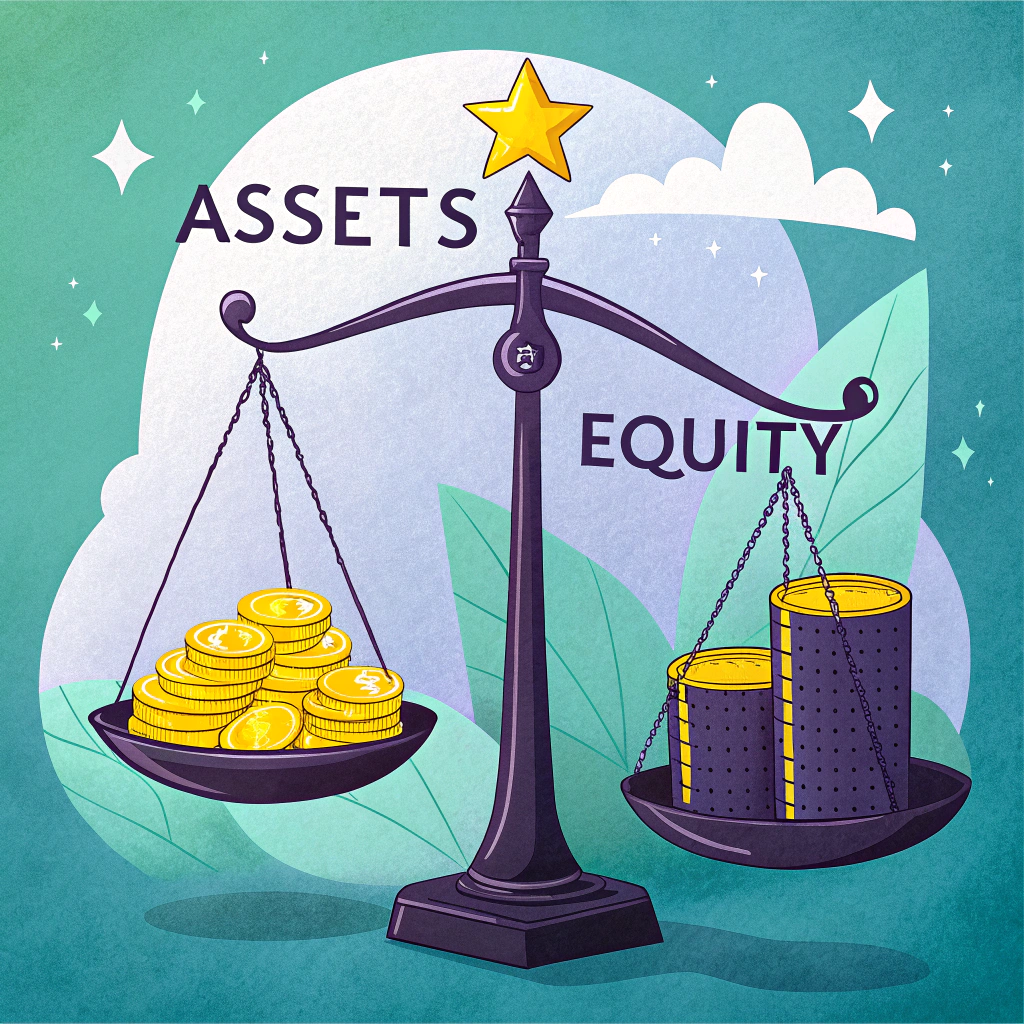Hey there, financial adventurers! Ever wondered how much of your company’s assets you truly own, and how much is on loan from your friendly neighborhood bank? That’s where the equity multiplier formula jumps into the spotlight. It’s like a backstage pass to your company’s financial performance, revealing how much of your assets are financed by shareholders’ equity versus debt. Intrigued yet?
Buckle up, because we’re about to dive into the thrilling world of equity multipliers, explore how to use this handy formula with real-life examples, and uncover why it’s a big deal.
What Is the Equity Multiplier Ratio?
Let’s keep it real—finance can sound like a foreign language sometimes. But the equity multiplier? It’s your new best friend for decoding how your company funds its assets. In plain English, the equity multiplier is a financial leverage ratio (fancy talk for a risk indicator) that measures what percentage of your company’s assets are financed by shareholders’ equity versus debt.
Mathematically, it’s calculated by dividing the total assets by the total shareholders’ equity. Yep, that’s it!
So, what’s the big deal? Well, a high equity multiplier is like a flashing neon sign saying, “We love debt!” It means the company is heavily relying on borrowed funds to finance its assets. On the flip side, a low equity multiplier whispers, “We’re playing it safe,” indicating that the company is less dependent on debt and is funding its assets primarily through equity.
But hold on a second—whether an equity multiplier is high or low isn’t just black and white. It’s all about context. You need to compare it with industry averages, historical standards, or see how it stacks up against the company’s competitors.
Remember, businesses need assets to operate and grow. And these assets are typically financed through equity (money from shareholders), debt (loans and borrowings), or a mix of both. Companies with more debt will have higher debt servicing costs—think of those pesky interest payments—which means they need to generate more cash flow to stay afloat.
Investors keep a keen eye on the equity multiplier ratio because it’s also a key component in the Dupont Formula, which measures a company’s performance based on key financial metrics.
Equity Multiplier Formula
Alright, time to get mathematical—but don’t worry, we promise it’s easier than calculating the tip on a dinner bill split five ways. The equity multiplier formula is straightforward:
Equity Multiplier = Total Assets / Total Shareholders’ Equity
That’s it!
But let’s unpack what goes into those two components:
- Total Assets: This includes everything the company owns—both current assets like cash, inventory, and accounts receivable, and non-current assets like property, plant, and equipment. Think of it as the company’s treasure chest filled with all its goodies.
- Shareholders’ Equity: This represents the owners’ stake in the company after all liabilities are subtracted from assets. It’s basically what’s left over if the company sold all its assets and paid off all its debts. Note that this typically includes common stock and retained earnings, but important to mention, preference shares usually don’t count here due to their fixed obligations.
Both these numbers can be found lounging around on the company’s balance sheet.

But here’s a pro tip: the equity multiplier isn’t a one-size-fits-all metric. Some industries are more capital-intensive than others, meaning they require more assets (and possibly more debt) to operate. So, to really get the scoop, you need to compare a company’s equity multiplier to those of its industry peers. If a company’s ratio is similar to the industry benchmark, then it’s par for the course—even if it’s higher or lower than other industries.
Related: Return on Assets Formula
Equity Multiplier Examples
Example 1: A&B Wears – Fashionably Leveraged?
Time to roll up our sleeves and get practical. Let’s consider A&B Wears, a trendy clothing company that’s caught your eye. Being the financial whiz that you are, you dive into their balance sheet and uncover the following nuggets:
- Current Assets: $37,000 (think cash, inventory flying off the shelves, maybe even a stash of designer scarves)
- Non-Current Assets: $143,000 (long-term investments, perhaps that chic storefront on the main avenue)
- Total Shareholders’ Equity: $540,000 (the owners’ slice of the pie)
First up, let’s calculate the total assets:
Total Assets = Current Assets + Non-Current Assets
Total Assets = $37,000 + $143,000 = $180,000
Now, let’s bring in our star formula:
Equity Multiplier = Total Assets / Total Shareholders’ Equity
Plugging in the numbers:
Equity Multiplier = $180,000 / $540,000
Equity Multiplier = 0.3333 or 33.33%
So, what does this tell us? Well, for every dollar of assets A&B Wears owns, about 33 cents are financed by equity. The rest? That’s covered by debt. Is that good or bad? It’s like fashion—depends on the season and who’s wearing it. You’ll need to compare this ratio with industry standards and peers to get the full picture.
Example 2: Edwin Company – Playing It Safe with Cables?
Next up, let’s look at Edwin Company, an internet solutions provider that supplies and installs internet cables for businesses and households. They’re gearing up to go public next year (exciting times!) and want to ensure their financials are attractive to potential investors and creditors.
Here’s what their last year’s reports show:
- Total Assets: $1,000,000 (think of all those cables, routers, and maybe even a fleet of tech vans)
- Total Shareholders’ Equity: $800,000 (the owners have a substantial stake)
Time to crunch the numbers:
Equity Multiplier = Total Assets / Total Shareholders’ Equity
Plugging in the numbers:
Equity Multiplier = $1,000,000 / $800,000
Equity Multiplier = 1.25
So, what’s the story here? An equity multiplier of 1.25 indicates that Edwin Company is using 20% debt to finance its assets (calculated as [($1,000,000 – $800,000) / $1,000,000] x 100). In other words, they’re funding 80% of their assets with equity and only 20% with debt. This conservative financing structure could make creditors and investors breathe a sigh of relief—they’re not over-leveraged, which might make them a safer bet. But remember, less debt might also mean slower growth potential. Context is key!
Equity Multiplier Interpretation and Analysis
Now, here’s the big question: Is a higher or lower equity multiplier better? Well, it’s not as simple as picking between coffee or tea (though for some, that’s a tough call). There’s no ideal equity multiplier that fits all because it varies across industries and sectors.
Generally speaking, investors tend to prefer companies with a lower equity multiplier. Why? Because it suggests the company isn’t overly reliant on debt to finance its assets. Less debt often means less financial risk—companies aren’t bogged down by hefty interest payments and can weather economic storms more smoothly.
But before you write off high equity multipliers as villains, remember that context is everything. In some cases, a higher equity multiplier might reflect a company’s strategic use of debt to achieve higher profitability. Maybe they’re leveraging debt to purchase assets at lower costs or to fuel aggressive growth. It’s like using a credit card to snag that limited-time offer—you might incur some debt, but the potential rewards could outweigh the costs.
For instance, an equity multiplier of 2 indicates that half of the company’s assets are financed by debt, and the other half by equity. Whether that’s good or bad depends on the company’s ability to manage that debt and the norms within its industry.
The equity multiplier also plays a starring role in the DuPont analysis, a method developed by the DuPont Corporation to assess a company’s financial performance. The DuPont model breaks down the Return on Equity (ROE) into three components: net profit margin, asset turnover ratio, and—you guessed it—the equity multiplier. This helps investors understand how much of the ROE is affected by financial leverage (the use of debt).
If there’s a significant change in ROE over time or a divergence from industry norms, the DuPont analysis can highlight whether fluctuations in the equity multiplier (i.e., changes in financial leverage) are driving that change. In simple terms, a higher equity multiplier can amplify ROE—but it also means taking on more debt-related risk.
Advantages of the Equity Multiplier
Indicator of Financial Strength
Think of the equity multiplier as your company’s financial X-ray vision. It reveals how much you’re relying on your own resources (equity) versus borrowed funds (debt) to finance your assets. A higher ratio suggests the company is leaning more on debt—maybe hitting the financial fast lane but also taking on more risk. A lower ratio indicates a stronger equity base and potentially a sturdier financial foundation.
Gauge of Financial Risk
If you’re an investor or creditor trying to avoid financial potholes, the equity multiplier is your GPS. A higher equity multiplier can signal elevated financial risk—the company may be more vulnerable to insolvency if it can’t meet its debt obligations. On the flip side, a lower multiplier might suggest a safer bet, with the company being less burdened by debt. It’s all about knowing how much risk you’re comfortable with.
Disadvantages of the Equity Multiplier
Now, before you go off singing praises to the equity multiplier, let’s play devil’s advocate. Like any metric, it has its quirks and limitations.
Accelerated Depreciation—The Shrinking Asset Dilemma
Sometimes, the equity multiplier can be a bit misleading due to accounting practices like accelerated depreciation. When a company aggressively depreciates its assets, the total assets on the balance sheet shrink faster than they might in reality. This can skew the equity multiplier, making it appear higher than it truly is. So it’s like looking at a funhouse mirror—things aren’t always as they seem.
Negative Working Capital—The Financial Puzzle
If a company has negative working capital (meaning current liabilities exceed current assets), the interpretation of the equity multiplier gets tricky. In such cases, some assets are essentially financed by liabilities that don’t have a direct cost, like accounts payable. This can distort the equity multiplier, making the general interpretations less reliable. It’s a bit like trying to read a map while spinning around—disorienting to say the least.
Because of these issues, it’s wise to use the equity multiplier alongside other financial metrics and not rely on it in isolation. Think of it as one tool in your financial toolkit—not the whole toolbox.

Is a Higher Equity Multiplier Better?
So, is bigger always better? Not necessarily. Generally, a lower equity multiplier is preferred because it suggests the company isn’t overloading on debt to finance its assets. Less debt can mean less financial risk—fewer interest payments to worry about and a lower chance of running into solvency issues.
However, it’s not a hard and fast rule. Some companies strategically use debt to fuel growth and may operate successfully with a higher equity multiplier. It’s all about how well the company manages its debt and whether it can generate sufficient returns to justify the increased leverage.
At the end of the day, the ideal equity multiplier depends on various factors—industry norms, company strategy, and overall financial health. Always consider the bigger picture before making judgments based solely on this ratio.
Takeaways
- The equity multiplier is a financial leverage ratio that measures the proportion of a company’s assets financed by shareholders’ equity versus debt.
- A higher equity multiplier indicates more debt financing relative to equity, increasing financial risk but potentially amplifying returns.
- A lower equity multiplier suggests the company relies less on debt and may be more financially stable but could have slower growth.
- Industry context matters—compare the equity multiplier to industry benchmarks and peers for meaningful insights.
- The equity multiplier is a key component of the Dupont analysis, helping to dissect the contributors to a company’s Return on Equity (ROE).
- While useful, the equity multiplier should be used alongside other financial metrics to provide a comprehensive view of a company’s financial health.
